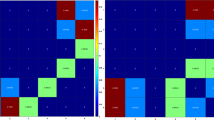Abstract
Latin hypercube sampling is often used to estimate the distribution function of a complicated function of many random variables. In so doing, it is typically necessary to choose a permutation matrix which minimizes the correlation among the cells in the hypercube layout. This problem can be formulated as a generalized, multi-dimensional assignment problem. For the two-dimensional case, we provide a polynomial algorithm. For higher dimensions, we offer effective heuristic and bounding procedures.
Similar content being viewed by others
References
E. Balas and M.J. Saltzman, Facets of the 3-index assignment problem, Discr. Appl. Math. 23(1989)201–229.
R. Chapman and H. Yakowitz, Evaluating the risks of solid waste management programs: A suggested approach, Resources and Conservation 11(1984)77–94.
R. Chapman, C.M. Harris and S.I. Gass, Analyzing the economic impacts of a military mobilization,Proc. Institute of Cost Analysis National Conf. (Springer, 1989) pp. 353–386.
C.M. Harris, Oil and gas supply modeling under uncertainty: Putting DOE midterm forecasts in perspective, Energy J. 4(1983)53–65.
C.M. Harris, Issues in sensitivity and statistical analysis of large-scale computer-based models, Technical Report NBS-GCR-84-466, National Bureau of Standards, U.S. Department of Commerce, Gaithersburg, MD 20899, USA (1984)
C.M. Harris, Computer generation of latin hypercube sampling plans, Technical Report NBS-GCR-84-476, National Bureau of Standards, U.S. Department of Commerce, Gaithersburg, MD 20899, USA (1984)
C.M. Harris, K.L. Hoffman and L.A. Yarrow, Obtaining minimum-correlation latin hypercube sampling plans using an IP-based heuristic (1995), OR Spektrum, to appear.
M. Held, P. Wolf and H.P. Crowder, Validation of subgradient optimization, Math. Progr. 6(1974)62–88.
R.L. Iman and W.J. Conover, Small sample sensitivity analysis techniques for computer models, with an application to risk assessment, Commun. Statist.-Theor. Meth. A9(1980)1749–1842.
R.L. Iman and W.J. Conover, A distribution-free approach to inducing correlation among input variables, Commun. Statist.-Simul. Comp. 11(1982)311–334.
A.B. Owen, Controlling correlations in latin hypercube samples, J. Amer. Statist. Assoc. 89(1990)1517–1522.
L.A. Yarrow, Obtaining minimum-correlation latin hypercube sampling plans using discrete optimization techniques, Ph.D. Dissertation, submitted to the faculty of the Department of Operations Research and Engineering, George Mason University, Fairfax, VA 22030, USA (1993).
Author information
Authors and Affiliations
Additional information
Supported in part by a grant from the National Institute of Standards and Technology (60NANB9D-0974).
Supported in part by grants from the Office of Naval Research (N00014-90-J-1324) and the Air Force Office of Scientific Research (F49 620-90-C-0022).
Research partially performed while visiting the Department of Mathematics, Brunel University, Uxbridge, England.
Rights and permissions
About this article
Cite this article
Harris, C.M., Hoffman, K.L. & Yarrow, LA. Using integer programming techniques for the solution of an experimental design problem. Ann Oper Res 58, 243–260 (1995). https://doi.org/10.1007/BF02032134
Issue Date:
DOI: https://doi.org/10.1007/BF02032134




